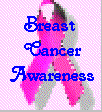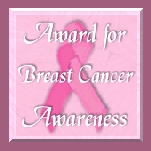


Cancer is what happens when a part of a person's body grows in an uncontrollable way and damages certain healthy parts. There are various types of cancer and these can originate from the head, skin and bone.
Brief On Breast Cancer
Breast cancer is the most common cancer in women and probably the most feared with about 30,000 new cases diagnosed each year in the UK with approximately 15,000 deaths. It is a common tumour and the most serious problem with breast cancer is that it may have a high tendency to spread elsewhere to distant parts of the body. This happens when the cancer is very aggressive, but because this cancer varies from person to person unlike other cancers, it may not spread at all even after several years in certain individuals. The risk of getting breast cancer has been calculated as 1 in 12 and the risk increases substantially in especially white women. But the fear that breast cancer holds for many women does not only lie in statistics but in the fact that the cancer attacks a part of the body which, for most women, is very important to her feelings of herself as a female and treatment often involves surgery to the breast.

No one knows what causes breast cancer. It is only known that breast cancer is much more common in countries with a Western lifestyle. However, it is not known what it is about these lifestyles that causes the women to develop breast cancer. There are several risk factors that can increase the chances of getting breast cancer and they include previous breast disease, race (with more white women at risk), women over 40 years old, women who are childless, women who have breast cancer running in the family as well as women who favour a high-protein, high-fat, low-carbohydrate and low-fibre diet. Women can help detect breast cancer early by examining their breasts regularly.
Signs to look out for are a lump or thickening in the breast, any change in outline or shape of the breast, puckering or dimpling of the skin on the breast, flaking of the skin on the breast, discharge from the nipple, an inverted nipple, swelling of the upper arm or armpit and any unusual pain or discomfort in the breast. Another way for women to help detect breast cancer early is to go for a baseline mammogram between the ages of 35-39 and to go for a mammogram every one to two years when they are between the ages of 40-49.

Once there is a positive diagnosis, the woman should go for further tests to ascertain the extent of the cancer. The surgical treatment for breast cancer will either be a lumpectomy when the lump is surgically removed on its own, leaving the rest of the breast intact, or a mastectomy, when part or all of the breast and the surrounding nodes and muscles are surgically removed. This may be followed by radiation therapy treatments which kills cancer cells by radiation. This is started when the skin has healed after the surgery. The frequency of the radiation treatment varies but is usually for a six-week period, about two to three times a week. The woman will then be required to attend her radiation therapy clinic at the hospital regularly for this treatment.
A lumpectomy is the first option for a small tumour which has not yet spread to the lymph nodes in the armpit. It involves surgical removal of the lump and, at the same time, the lymph nodes are checked for the spread of the disease. After the operation, the woman's breast will not look very different from the way it did before. This is followed by X-ray treatment and/or anti-cancer drugs. Whether a woman can have a lumpectomy or not depends very much on the stage of the disease and is mostly done when the cancer is diagnosed early.
Mastectomy is the partial or complete removal of the breast. It is used in conjunction with drugs and X-ray treatment whenever there is danger of the cancer spreading. After the operation, the woman is given counselling and support to help her get over the grief about the "mutilation". She may also be given physical therapy as the arm and shoulder on the side of the missing breast are often stiff after the operation. She will also need post-operation drugs and/or X-ray treatments in which there are often unpleasant side-effects such as hair loss, retching or sore throat. To end any embarrassment to the shape of the body after the operation, the woman is given a temporary light breast form to fit inside her bra. When the tenderness around the scar has faded, she can then have a prosthesis fitted. The final stage is reconstructing the breast by mammoplasty three months after the mastectomy and this reconstruction is vital to most women as a return to normal life.
After the amputation of a breast, the woman not only has to recover from the physical discomfort but also from the heavy mental strain. There are several self-help groups associated with mastectomies and breast cancer and they can help these women feel less alone and even give them practical solutions to any problem that is worrying them.

The cancer of the breast is often associated with women only but unfortunately this is not the case. Men too get breast cancer although it is very rare. There are approximately 200 cases a year and they occur mainly in men over the age of 60. Breast cancer in men is very similar to the cancer in women and it is treated by the removal of the breast tissue. Symptoms are fairly similar with the usual lump on the breast.

It is ideal that one should try to detect any form of trouble especially a common and potentially serious problem such as breast cancer. The three most important elements are assessments by your doctor, regular mammography sessions and self-examinations. With attention paid to these elements, breast cancer CAN be dealt with easily.
Author: Whitehouse and Slevin
Title of Book: Cancer, The Facts (Second Edition)
Publisher: Oxford University Press
Author: Hirshaut, Yashar (M.D., F.A.C.P) and Peter I. Pressman (M.D., F.A.C.S.)
Title of Book: Breast Cancer, The Complete Guide
Publisher: Bantam Books
Author: Buckman, Robert (Dr)
Title of Book: What You Really Need To Know About Cancer
Publisher: MacMillan Books
Author: Fallowfield, Lesley with Andrew Clark
Title of Book: Breast Cancer
Publisher: Tavistock/Routledge
Author: Sherry, Michael M (M.D.)
Title of Book: Confronting Cancer
Publisher: Insight Books
Author: Stoppard, Miriam (Dr)
Title of Book: Every Woman's Medical Handbook
Publisher: Ballantine Books


 for the beautiful graphics.
for the beautiful graphics.
| Breast Cancer Awareness Ring | ||
 |
This Breast Cancer Awareness Ring site is owned by: Christina Tan Want to join the Breast Cancer Awareness ring? |
 |
| Prev Page Skip Next Random Site Next 5 List Sites | ||

 This
Messages With Meaning site is owned by
This
Messages With Meaning site is owned by Christina Tan. Want to join the Messages With Meaning? |
|---|
| [Skip Prev] [Prev] [Next] [Skip Next] [Random] [Next 5] [List Sites] |


